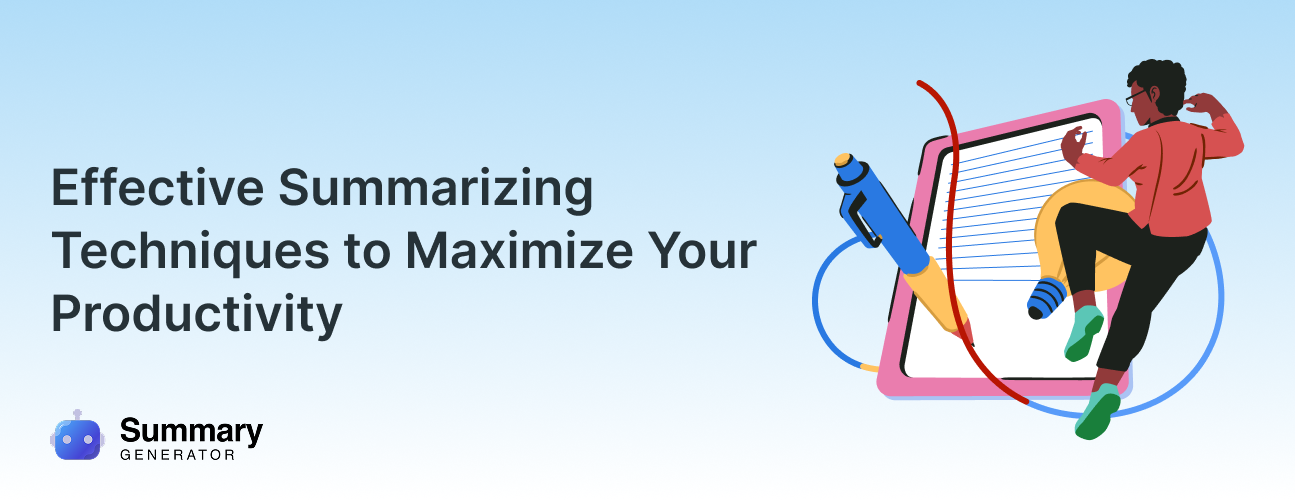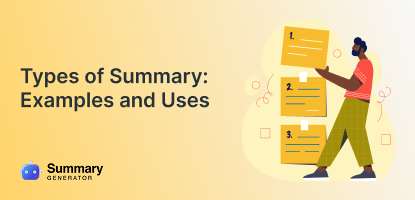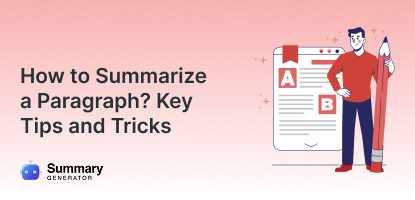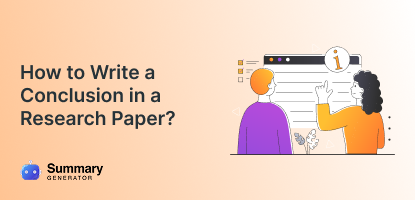Although summarizing seems easy and a quick job to do, it’s not. Instead, summarizing a piece of content perfectly requires time, effort, and skills.
Don’t you have much time to summarize the content? Or do you need to summarize multiple reports on a daily basis? In each case, this article can help.
Here we will share the best techniques to maximize your productivity and help you sum up your reports quickly.
Let’s get ourselves acquainted with them!
Best Techniques to Summarize Content
The One-Sentence Summary
It’s one of the best methods to condense information or write conclusions without wasting time. Whenever you want to wrap up your reports or assignments, try to summarize them in one sentence without ruining the essence. The goal is to preserve the core message while discarding all the extras.
How to do it?
- Read the full content.
- Ask yourself: What’s the main point?
- Write one sentence that captures it.
That’s it. Yes, sometimes you might not be able to summarize an entire paragraph or article in one sentence. However, with some practice, you will surely understand how to do it effortlessly.
When to Use this Technique?
- When you are preparing notes.
- Drafting presentation points.
- Reviewing meeting recaps.
The Bullet-Point Method
The one-sentence summary method doesn’t always work. Sometimes, you must add critical information to the text to make your summary impactful. In such cases, you can use the bullet-point method. It’s short, quick, and easy to understand for readers.
Bullet points help you distill large chunks into bite-sized takeaways. They’re ideal when the material has multiple ideas or steps.
How to do it?
- Break the content into its key ideas.
- Start each point with a strong word.
- Keep each bullet short.
Example:
Topic: Benefits of Exercise
- Improves mood and energy
- Enhances brain function
- Boosts the immune system
- Reduces stress and anxiety
This format speeds up review time and makes retention easier.
When to Use this Technique?
- Making study notes.
- Writing training guides.
- Preparing checklists.
Mind Mapping
Some ideas are a bit harder to reduce linearly. That’s where mind maps come in. Instead of paragraphs or bullet points, use a visual layout. Place the main idea at the center, and branch related topics or facts outward.
Mind maps give you a clear structure at a glance. They are invaluable for planning, brainstorming, and summarizing large bodies of scattered information.
How to do it?
- Write the main idea in the center of a blank page.
- Add branches for each subtopic.
- Keep each label short.
- Connect related ideas with lines or colors.
Example:
If the core idea is “Time Management,” the branches might be:
- Tasks
- Tools
- Habits
- Prioritization
When to Use this Technique?
- Organizing messy ideas.
- Planning large projects.
- Studying overlapping topics.
Feynman Technique
This method is also quite popular among professionals who frequently need to explain things to their readers. This method is named after the famous physicist Richard Feynman. In this method, you need to understand the entire subject first. After that, you explain it like you are teaching a kid. Using the Feynman technique, you can easily summarize any content without putting much effort into it.
How to do it?
- Read and understand the concept.
- Pretend to teach it in plain language.
- Identify gaps in your explanation.
- Revisit the material and refine.
When to Use this Technique?
- Studying complex topics.
- Writing explainers.
- Training new team members.
The 5W1H Method
This method is commonly used by journalists to extract essential facts quickly. It strips any opinion or excess from content and focuses on clear answers.
How to do it?
It’s very simple. Just ask the six questions and then write short answers.
Example:
Topic: New App Launch
- Who: Apple
- What: Released new fitness app
- When: May 2025
- Where: Global rollout
- Why: Tapping into the wellness market
- How: Integrated with iPhone health data
In a few lines, you know what happened, who did it, and why it matters.
When to Use this Technique?
- Summarizing news.
- Reviewing meetings.
- Preparing project briefs.
The Inverted Pyramid
Here’s another method used by many journalists. It’s also very helpful for summarizing any type of content. This method starts with the most critical detail, followed by supporting facts, and ends with extra context.
How to do it?
- Identify the main conclusion or key detail.
- Add supporting points that explain or prove it.
- Tuck less relevant info at the bottom.
Example:
Top: New law passed restricting phone use in schools.
Middle: Schools must install signal blockers. Parents can access during emergencies.
Bottom: The Law takes effect in September.
When to Use this Method?
- Writing emails.
- Reporting updates.
- Creating briefs.
Use Summarizing Tools
Finally, here we have the easiest method to sum up different types of studies. All the manual summarizing methods require some time and effort. Want to avoid them? Use an AI-powered summarizing tool to write summaries for you. It will quickly wrap up your studies while maintaining the essence and ensuring accuracy.
How to do it?
- Simply paste your text in Summarygenerator.io
- Select your preferences.
- Copy and paste results.
- Review and refine the content a bit.
When to Use this Method?
- You are swamped with reading.
- Reviewing long reports.
- Speed-skimming research.
Conclusion
In the last analysis, summarizing content is easy but takes time. However, using the right summarizing techniques can save your time and make your summaries worth reading. Here, we have shared some of the best methods you can use to recap your articles with ease. Choose the correct method according to your needs, and you will surely be able to enhance productivity.



